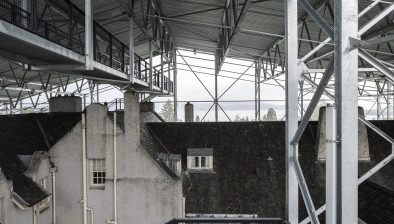Plan to enclose Mackintosh’s Hill House beneath 60ft protective veil
 The National Trust for Scotland has unveiled plans to cover Charles Rennie Mackintosh’s Hill House in Helensburgh with a 60 feet tall enclosure amidst mounting concern for the building’s structural integrity.
The National Trust for Scotland has unveiled plans to cover Charles Rennie Mackintosh’s Hill House in Helensburgh with a 60 feet tall enclosure amidst mounting concern for the building’s structural integrity.
Architects at Carmody Groarke have been commissioned to create what the Trust calls “a colossal yet sublime” enclosure to protect the property from the elements and provide conservationists with a much-needed breathing space to devise longer-term solutions.
Hill House is one of Charles Rennie Mackintosh’s most significant works, one of Scotland’s most acclaimed buildings, and a seminal part of early 20th century European architecture. The building has had huge influence on architecture and design in Scotland, Europe and globally.
Built in 1928, 30km west of Glasgow, the unusual hybridisation of tradition and invention in the construction of the building has led to some fundamental long-term problems that require a major conservation project to help the house survive.
 As an integral part of this process of conservation which will take up to 12 years, the project proposes a ‘big-box’ museum to contain and protect the Hill House as an ‘artefact’.
As an integral part of this process of conservation which will take up to 12 years, the project proposes a ‘big-box’ museum to contain and protect the Hill House as an ‘artefact’.
The new museum’s architectural identity will be a huge, abstracted garden pavilion drying-shed covered entirely with a perforated mesh. This semi-permanent enclosure provides basic shelter to the original house whilst its rain-soaked existing walls are deconstructed to allow their fabric to fully dry out. This delicate enclosure will also allow uninterrupted views, night-and-day, to-and-from the landscape to Mackintosh’s architectural icon.
Within this safe, sheltered construction working territory, the “museum” will provide a remarkable public visitor experience of the conservation in progress, achieved by an elevated walkway which loops around the Hill House at high level.
Andy Groarke of Carmody Groarke said: “The National Trust of Scotland are adopting a very bold approach to the conservation of the Hill House; one that is radical and experimental in seeking new methods to extend the lifespan of our heritage, and one that invites public interaction and interpretation of these processes.”
The enclosure could be in place next year subject to a New Year fundraising drive and could remain in-situ for years thereafter.




















